Injection Mold Tool Design Ppt
Injection molding is a common manufacturing process used to make components made of metals, polymers, glasses, confections and other materials. Pellets of material are melted and then injected at high pressure into a mold that will set to form the desired component. Here are 11 common injection molding defects to watch out for when inspecting injection-molded products, what the causes are and how you can avoid them.
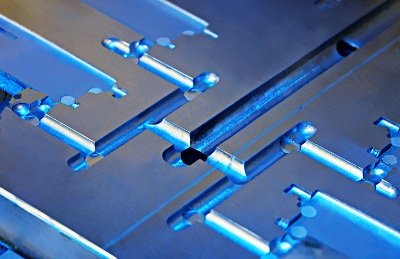 There's a lot of room for expensive errors when it comes to injection molding. Quality issues in injection-molded products can range from minor surface defects to more serious problems that can affect the safety, performance and function of the product. They can be caused by problems related to the molding process, material use, tooling design or a combination of all three.
There's a lot of room for expensive errors when it comes to injection molding. Quality issues in injection-molded products can range from minor surface defects to more serious problems that can affect the safety, performance and function of the product. They can be caused by problems related to the molding process, material use, tooling design or a combination of all three.
But as with any quality problems, knowing how molding defects arise is half the battle (related: How Experienced Importers Limit Product Defects in 3 Stages [eBook]). As an importer or manufacturer of injection-molded products, some knowledge of common molding defects and how to avoid them can help you cut costs related to unsellable goods and product returns.
Let's look at the most common quality defects related to injection molding, what causes them and what you can do to prevent them.
Molding defects often caused by process problems
Some molding defects may be difficult or costly to address. Others can be prevented by adjusting the molding process, without the need to redesign the mold tooling or replace other production equipment. You can typically avoid these defects relatively easily simply by adjusting the flow rate, temperature or pressure of your mold.
1. Flow lines
Flow lines appear as a wavy pattern often of a slightly different color than the surrounding area and generally on narrower sections of the molded component. They may also appear as ring-shaped bands on a product's surface near the entry points of the mold, or "gates", which the molten material flows through. Flow marks won't typically impact the integrity of the component. But they can be unsightly and may be unacceptable if found in certain consumer products, such as high-end sunglasses.
Causes and remedies for flow lines
Flow lines are most often the result of variations in the cooling speed of the material as it flows in different directions throughout the mold. Differences in wall thickness can also cause the material to cool at different rates, leaving behind flow lines.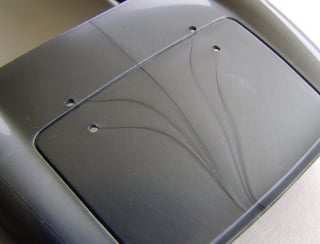 For example, molten plastic, cools very quickly during the injection process and flow marks are evident when the injection speed is too slow. The plastic becomes partially solid and gummy while still filling the mold, causing the wave pattern to appear.
For example, molten plastic, cools very quickly during the injection process and flow marks are evident when the injection speed is too slow. The plastic becomes partially solid and gummy while still filling the mold, causing the wave pattern to appear.
Here are some common remedies for flow lines in injection-molded products:
- Increase the injection speed, pressure and material temperature to ensure the material fills the mold before cooling
- Round the corners of the mold where wall thickness increases to help keep flow rate consistent and prevent flow lines
- Relocate mold gates to create more distance between them and the mold coolant to help prevent the material from cooling too early during flow
- Increase the nozzle diameter to raise flow speed and prevent early cooling
2. Burn marks
Burn marks typically appear as black or rust-colored discoloration on an edge or surface of a molded plastic part.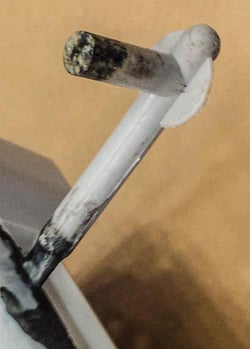 Burn marks generally don't affect part integrity, unless the plastic is burned to the extent of degradation.
Burn marks generally don't affect part integrity, unless the plastic is burned to the extent of degradation.
Causes and prevention of burn marks
The usual cause for burn marks in injection-molded parts is trapped air, or the resin itself, overheating in the mold cavity during injection. Excessive injection speeds or heating of the material often lead to overheating that causes burns. Consider the following preventative measures to avoid burn marks in molded components:
- Lower the melt and mold temperature to prevent overheating
- Reduce the injection speed to limit the risk of trapping air inside the mold
- Enlarge gas vents and gates to allow trapped air to escape the mold
- Shorten the mold cycle time so that any trapped air and resin don't have a chance to overheat
3. Warping
Warping is deformation that can occur in injection molded products when different parts of a component shrink unevenly. Just as wood can warp when it dries unevenly, plastic and other materials can warp during the cooling process when uneven shrinkage puts undue stress on different areas of the molded part. This undue stress results in bending or twisting of the finished part as it cools. This is evident in a part that's meant to lie flat but leaves a gap when laid on a flat surface.
Causes and prevention of warping in molded parts
One of the main causes for warping in injection-molded plastic and similar materials is that cooling happens too quickly. 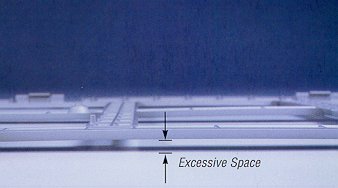 Often excessive temperature or low thermal conductivity of the molten material can worsen the problem. Other times mold design can contribute to warping when the walls of the mold are not of uniform thickness—shrinkage increases with wall thickness. Here are some common ways to prevent warping in your molded parts:
Often excessive temperature or low thermal conductivity of the molten material can worsen the problem. Other times mold design can contribute to warping when the walls of the mold are not of uniform thickness—shrinkage increases with wall thickness. Here are some common ways to prevent warping in your molded parts:
- Ensure the cooling process is gradual and long enough to prevent uneven stresses on the material
- Lower the temperature of the material or mold
- Try switching to a material that shrinks less during cooling (e.g. particle-filled thermoplastics shrink much less than semi-crystalline materials or unfilled grades)
- Redesign the mold with uniform wall thickness and part symmetry to ensure greater stability in the part during cooling
4. Vacuum voids / air pockets
Vacuum voids, or air pockets, are trapped air bubbles that appear in a finished molded component. Quality control professionals typically consider voids to be a "minor" defect (related: 3 Types of Quality Defects in Different Products). 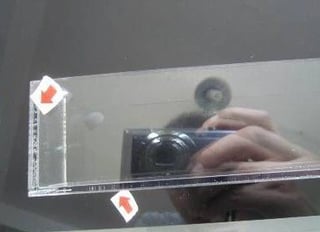 But larger or more numerous voids can weaken the molded part in some cases, as there's air below the surface of the part where there should be molded material.
But larger or more numerous voids can weaken the molded part in some cases, as there's air below the surface of the part where there should be molded material.
Common causes of and steps to prevent vacuum voids in molded parts
One of the chief causes of voids is inadequate molding pressure to force trapped air out of the mold cavity. Other times, the material closest to the mold wall cools too quickly, causing the material to harden and pull the material toward the outside, creating an abscess. The material itself may be especially vulnerable to voids if its density changes significantly from the molten to hardened state. Voids are more difficult to avoid in molded parts which are thicker than 6 mm. Common ways to prevent voids include:
- Raise the injection pressure to force out trapped air pockets
- Choose a grade of material with lower viscosity to limit the risk of air bubbles forming
- Place gates close to the thickest parts of the mold to prevent premature cooling where the material is most vulnerable to voids
5. Sink marks
Sink marks are small recesses or depressions in an otherwise flat and consistent surface of a molded part. These can occur when the inner part of a molded component shrinks, pulling material from the outside inward.
Causes and prevention of sink marks
Sink marks are similar to vacuum voids but are reversed in cause and effect.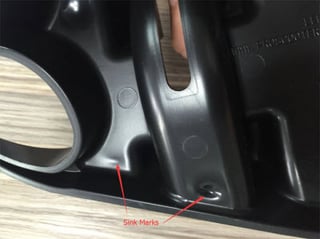 Rather than the material cooling too rapidly near the exterior of the part, the material cools too slowly. The resulting shrinkage pulls the outside material inward before it's had a chance to adequately cool, leading to a depression. As with voids, sink marks are more likely to occur in thicker parts of a component. Here are some steps you can take to prevent this defect:
Rather than the material cooling too rapidly near the exterior of the part, the material cools too slowly. The resulting shrinkage pulls the outside material inward before it's had a chance to adequately cool, leading to a depression. As with voids, sink marks are more likely to occur in thicker parts of a component. Here are some steps you can take to prevent this defect:
- Increase holding pressure and time to allow the material near the part's surface to cool
- Increase cooling time to limit shrinkage
- Design your mold with thinner component walls to allow for faster cooling near the surface
6. Weld lines
Weld lines can appear on the surface of a molded part where the molten material has converged after splitting off into two or more directions in a mold. The hair-like weld line is the result of weak material bonding, which lowers the strength of the part.
Common causes of weld lines and how to prevent them
Two or more fronts of polymer or other molten material need to maintain a certain temperature when colliding. 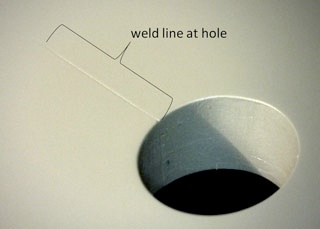 Otherwise, they become partially solidified and won't sufficiently bond where they meet, resulting in weld lines. Common remedies for weld lines in molded parts include:
Otherwise, they become partially solidified and won't sufficiently bond where they meet, resulting in weld lines. Common remedies for weld lines in molded parts include:
- Increase material temperature to prevent partial solidification
- Raise injection speed and pressure to limit cooling before the material has filled the mold
- Redesign the mold to eliminate partitions
- Switch to a material with a lower melting temperature or viscosity to allow faster flow and prevent early cooling
7. Jetting
Jetting refers to a kind of deformation in a molded component that can occur when there's an initial "jet" of molten material injected into the mold cavity that starts to solidify before the cavity is filled. Jetting often appears as a squiggly line in the surface of the finished component, typically leading from the initial gate of injection. This visible flow pattern can result in part weakness.
Causes and remedies of jetting in molded parts
The chief cause for jetting is excessive injection pressure. 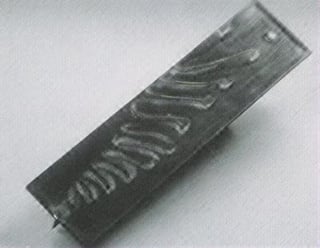 When molten polymer or other material is injected through a small gate at high pressure it often squirts rapidly through the gate, rather than filling the mold cavity gradually. As this initial line of material cools against the mold walls and starts to harden, the remaining mold material pushes it, leaving impressions in the surface of the finished part. Avoid jetting in molded parts by:
When molten polymer or other material is injected through a small gate at high pressure it often squirts rapidly through the gate, rather than filling the mold cavity gradually. As this initial line of material cools against the mold walls and starts to harden, the remaining mold material pushes it, leaving impressions in the surface of the finished part. Avoid jetting in molded parts by:
- Reducing injection pressure to prevent rapid squirting of the material into the mold cavity
- Increasing material and mold temperature to keep the initial jet of material from solidifying early
- Designing the mold with the injection gate located such that the material is directed across the mold, rather than lengthwise
Defects typically related to material use or storage
Injection molding defects can often originate from the material itself or how the manufacturer stores and handles the material prior to the production process. These defects can range from minor aesthetic issues to compromised strength of the finished component. Serious safety concerns may also result, depending on the intended application of the product affected.
8. Discoloration
Discoloration, or "color streaking", occurs when a molded part is a different color than intended. Often the discoloration is limited to a localized area or a few streaks of abnormal color on a molded part. This defect typically affects the appearance of the part without reducing its strength.
Causes of discoloration in molded products and how to prevent it
A common cause of discoloration is leftover pellets in the hopper or residual resin in the nozzle or mold from a previous production run. 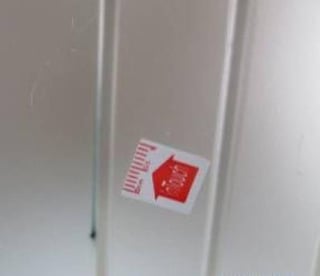 Poor thermal stability of the coloring agent or improper mixing of the masterbatch are other potential causes. Take the following precautions to limit the risk of discoloration in your injection-molded products:
Poor thermal stability of the coloring agent or improper mixing of the masterbatch are other potential causes. Take the following precautions to limit the risk of discoloration in your injection-molded products:
- Ensure that workers properly clean the hopper, nozzle and mold between production runs to eliminate any residual pellets or base material
- Consider using a purging compound to remove excess color from the machine
- Ensure you or your supplier is using a color agent with adequate thermal stability
- Ensure that the masterbatch is evenly mixed for consistent color output
9. Delamination
If you find thin layers on the surface of a molded part are easily separating or peeling off the underlying material, you're seeing a molding defect called delamination. Delamination is a defect characterized by a flaking surface layer, similar to what you'd commonly find on flake mica. This is generally regarded as a relatively serious defect because it reduces the strength of the component.
Causes and prevention of delamination in injection molding
The most common cause of delamination is contamination of the resin pellets or other base material with a foreign material. Flaky separation results when the two materials cannot properly bond to each other. For example, you might combine a common base plastic like acrylonitrile butadiene styrene (ABS) with an incompatible plastic, such as polypropylene (PP). The resulting loss of strength of the material would be very dangerous if your part is intended for a safety-critical use.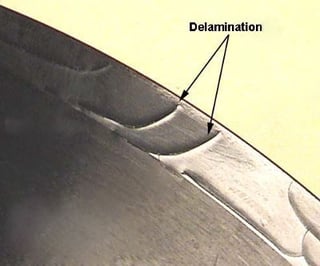
Aside from material fed into the hopper, the contaminant could also be any excess release agents coating the mold for easier component separation. Excess moisture on the material, due to improper drying prior to use, can also cause delamination. Consider the following corrective actions to prevent recurrence if you discover delamination affecting your molded parts:
- Increase the mold temperature or pre-dry the material properly if excess moisture is an issue
- Ensure workers are properly storing and handling the resin pellets or base material to prevent contamination
- Consider redesigning the mold with a focus on the injection nozzle to limit your dependence on release agents
Injection molding defects caused by poor mold design or maintenance
Defects can be introduced into molded products by issues with the mold tooling itself. Certain defects are likely to occur when the mold is poorly maintained or designed. Especially in the latter case, these defects can be difficult or costly to address in future production runs when it's necessary to completely overhaul the mold.
10. Short shot
A short shot occurs when the flow of molten material doesn't completely fill the cavities in a mold. The result is that the molded component is incomplete after cooling. Short shot might appear as incomplete compartments in plastic shelves of a display or missing prongs on a plastic fork, for example. Short shots are typically classified as a major defect that can inhibit the function or appearance of the molded part.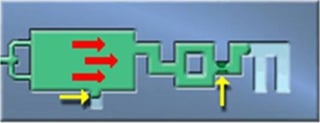
Causes and remedies of short shot in molded products
The most common cause of short shots is flow restriction resulting from narrow or blocked gates. Sometimes the material is too viscous or the mold is too cold to allow the molten material to completely fill the mold before cooling. And other times trapped air pockets may be hindering proper flow or injection pressure may be inadequate. Consider the following steps to prevent short shot:
- Redesign the mold with wider channels or gates for better flow
- Increase injection speed or pressure or choose a thinner base material to improve flow
- Increase mold temperature to prevent material from cooling too rapidly
- Add additional air vents or enlarge existing vents in the mold to allow trapped air to escape
11. Flash
Flash, also called "spew" or "burrs", is an excess of molding material that appears as a thin lip or protrusion at the edge of a component. Flash appears because material has flowed outside of the intended flow channels and into the space between the tooling plates or at the injector pin. 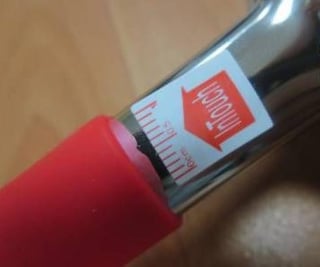 Flash is usually subtle but might be considered a major defect if particularly obvious on a product. The process for reworking a molded product with flash often includes trimming the excess material.
Flash is usually subtle but might be considered a major defect if particularly obvious on a product. The process for reworking a molded product with flash often includes trimming the excess material.
Common causes of flash and prevention in molded products
A poorly-designed or worn and degraded mold is the most common contributor to flash. Excessively high mold temperature or injection pressure can also cause flash. Material flowing through the mold cavities can force its way between plates when plate clamping force is inadequate. Common methods for addressing flash in molded products include:
- Retool or redesign the mold if plates don't fit together properly or allow material to flow outside the channel
- Increase plate clamping force to confine material flow to the channel
- Adjust mold temperature, injection pressure and ventilation to improve material flow
Conclusion
Manufacturing using injection molding typically requires significant upfront investment in tooling. That's why it's especially important to design your mold right the first time, rather than having to start again after finding serious defects. Defects related to the molding process or material tend to be easier and less costly to solve. But no matter the cause, defects in molded products can hurt your bottom line tremendously.
Now that you're familiar with common injection molding defects to look out for, you can take steps to prevent them in the future and ensure your products meet your customers' quality standards.
Do you have any other advice for addressing defects in injection-molded products? Share your tips in the comments section below!
Injection Mold Tool Design Ppt
Source: https://www.intouch-quality.com/blog/injection-molding-defects-and-how-to-prevent
Posted by: moonalock1990.blogspot.com

0 Response to "Injection Mold Tool Design Ppt"
Post a Comment